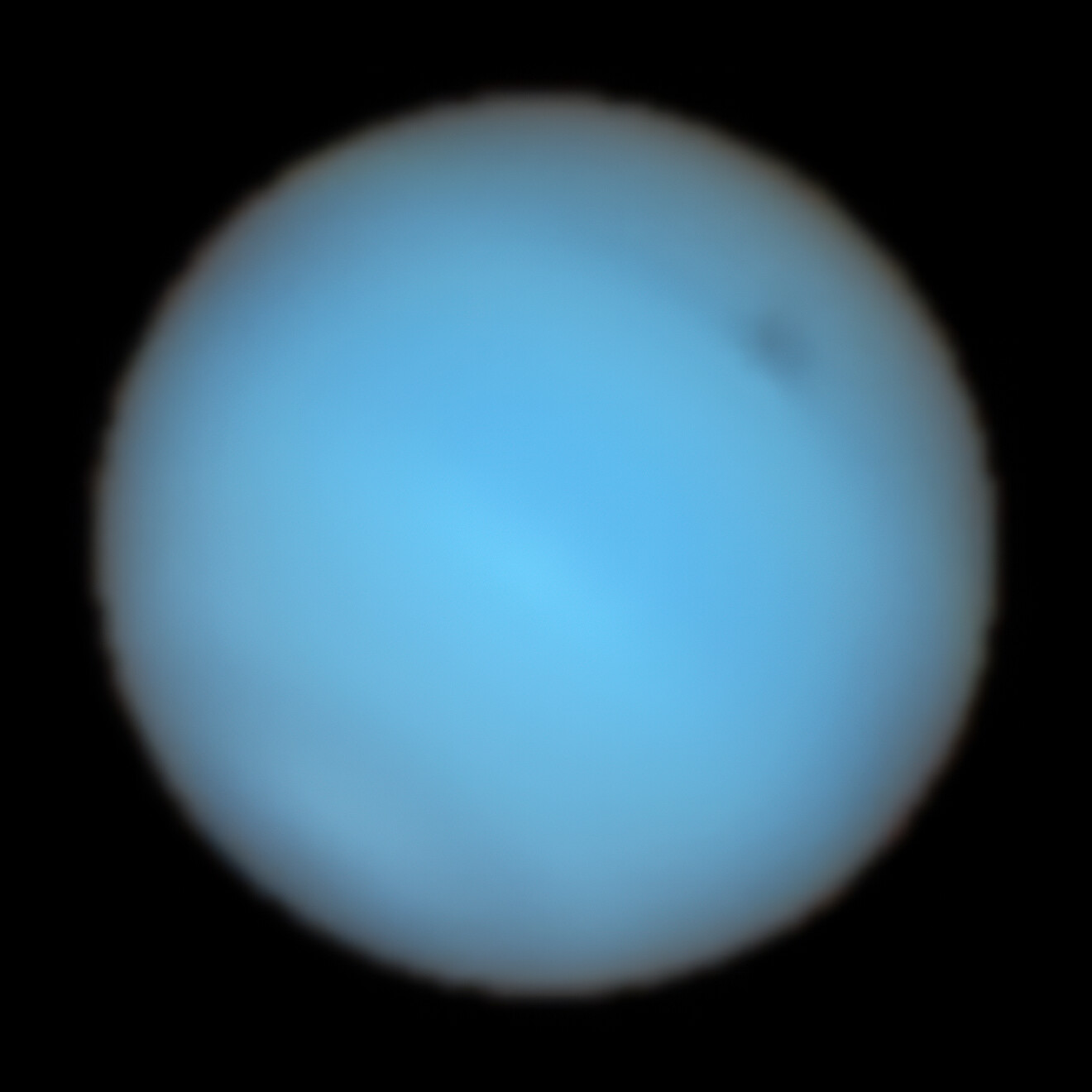Weird dark spot on Neptune may have a bright spot buddy
The first-ever ground-based image of a dark spot on Neptune has revealed vital clues as to the origin of such anticyclonic vortices.
In 2018, a dark spot appeared in Neptune’s atmosphere, giving astronomers a terrific opportunity to finally figure out what these sorts of shadowy apparitions are.
When Voyager 2 encountered Neptune in 1989, it saw that the blue ice giant’s northern hemisphere was adorned with a huge, dark anticyclonic vortex that was thousands of miles in diameter. Then, the blemish went away.
Over the years since that Voyager 2 fly-by, the Hubble Space Telescope has observed similar dark spots come and go in both of Neptune’s hemispheres. At first glance, the blobs appear similar to Jupiter’s famous Great Red Spot (GRS), but the GRS has been steadily swirling for at least 350 years and is found high up in Jupiter’s atmosphere. By contrast, Neptune’s dark spots seem to only last for a few years and reside deeper into the ice giant’s atmosphere.
So when Hubble observed another dark spot on Neptune in 2018, a team of astronomers, led by Patrick Irwin of the University of Oxford, sprang into action.
Related: Neptune's clouds have vanished, and the sun may be to blame (video)
Neptune’s dark spots had never been observed by a ground-based telescope before, but with the European Southern Observatory’s Very Large Telescope (VLT) in Chile and its MUSE (Multi Unit Spectroscopic Explorer) instrument, Irwin’s team was able to detect the dark spot and spectroscopically measure it in 3D, revealing what was going on with this entity at different atmospheric depths.
In doing so, they discovered some possible answers as to the dark spot’s mysterious origin. They published a paper on their findings on Thursday (Aug. 24) in the journal Nature Astronomy.
Breaking space news, the latest updates on rocket launches, skywatching events and more!
"Since the first discovery of a dark spot, I’ve always wondered what these short-lived and elusive dark features are," Irwin said in the statement.
Different wavelengths of light are able to probe different depths of Neptune’s atmosphere, dictated by things like atmospheric composition and how that composition reflects light.
Using MUSE, Irwin’s team created a three-dimensional reflection spectrum, which showed how the planet's atmosphere at varying depths reflects sunlight. The dark spot, designated NDS-2018, appeared to fall within a region of the atmosphere that doesn’t reflect much of that light. These observations, made in 2019, thus rule out the possibility that the dark spot is simply a clearing in Neptune’s clouds providing a view of darker layers situated below.
Instead, the team reasoned, something in the atmosphere's aerosol haze must be making this spot dark. MUSE’s observations showed the dark spot likely lies at a depth where the pressure is about 5 bar, which is the pressure layer where hydrogen sulfide is able to condense out into ice crystals.
Irwin’s team has identified two explanations for why this is the case.
Since hydrogen sulfide is a light-sensitive gas, one possibility is the dark spot is caused by an upwelling at the center of the vortex that is bringing up hydrogen sulfide from deeper inside the planet. When the hydrogen sulfide reaches an altitude where it can react with solar ultraviolet light, the reaction perhaps causes the atmosphere to darken. The other possibility is the hydrogen sulfide has condensed around darker particles, and local heating caused by anticyclonic conditions causes the hydrogen sulfide to sublimate, revealing those darker particles beneath.
The VLT’s observations also offered up an additional surprise: a small bright spot, designated DBS-2019, on the south-west edge of the dark spot.
"In the process [of observing the dark spot] we discovered a rare, deep, bright cloud type that had never been identified before, even from space," Michael Wong, a planetary scientist from the University of California, Berkeley, and a member of Irwin’s team, said in the statement.
Bright spots of one kind or another have been seen regularly, even from Earth, in the atmosphere of Neptune. Voyager 2, for instance, discovered bright clouds of methane that were nicknamed "scooters" because of how they moved around the planet so quickly. However, DBS-2019 seems to be at a much lower depth than the scooters, sharing an altitude with the dark spot itself. It may actually be that the bright spot is the result of convection at the edge of the dark spot’s vortex, perhaps pumping brighter material up from the murky, frozen depths below.
Alas, the observations of both the dark and bright spots were fleeting; they disappeared in 2022.
Currently, Neptune’s atmosphere appears spotless, its cloud coverage having vanished. The disappearance of the clouds may be related to the sun’s solar cycle of activity and a drop in photoionizing ultraviolet light during solar minimum in 2019. This process may have a role to play in the formation of Neptune’s clouds; take it away and the clouds begin to disappear. If this hypothesis is correct, we should expect to see a more active Neptunian atmosphere after solar maximum in 2024-2025.
Now astronomers must wait for a new dark spot to arise to continue their studies from Earth, at least until a space mission sets sail once again to follow in Voyager 2’s footsteps and visit the last planet of the solar system.
A paper on the research was published on Aug. 24 in the journal Nature Astronomy.

Keith Cooper is a freelance science journalist and editor in the United Kingdom, and has a degree in physics and astrophysics from the University of Manchester. He's the author of "The Contact Paradox: Challenging Our Assumptions in the Search for Extraterrestrial Intelligence" (Bloomsbury Sigma, 2020) and has written articles on astronomy, space, physics and astrobiology for a multitude of magazines and websites.



